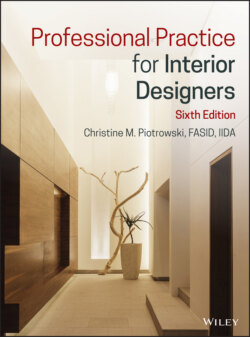Читать книгу Professional Practice for Interior Designers - Christine M. Piotrowski - Страница 38
LIFELONG LEARNING
ОглавлениеRegardless of the type of interior design one practices, professionals must be ready to embrace lifelong learning. Technical updating is a paramount need for most designers. Others may want access to topics related to a specific design specialty. Business owners often seek professional education on business practices. Like all other professionals, interior designers should seek out continuing lifelong learning opportunities.
Professional education generally is represented via seminars, workshops, lectures, correspondence courses, online seminars, webinars, and intensive professional studies that meet individual needs. These continuing education offerings are available in almost every topic and area of the profession.
Educational programs that provide continuing education units (CEU) furnish short‐term coursework in a wide variety of topical‐interest areas. This is the most common way for professionals to obtain lifelong learning opportunities. CEU classes provide a means for professional interior designers to remain current in the practice of interior design. Courses that provide CEU credits are those that have been approved by a reviewing body. Not all seminars and workshops provide approved CEU credits.
Continuing education is also very important because jurisdictions that have passed licensing or title registration acts require continuing education for maintaining registration. Professional associations also require continuing education for their members. The exact requirements vary, and it is the individual's responsibly to understand any licensing board or organizational requirements. In most cases, these entities will require approved CEU credits.
Continuing education courses are held for anywhere from one or two hours to perhaps a full day, and a participant will earn one‐tenth of an hour of credit (0.1) for each hour of the class. These courses and workshops are also developed to be of differing difficulty. A course may be very basic in nature, meaning that anyone is likely to gain from taking the course. Advanced courses generally expect that participants have some to fairly extensive knowledge in the subject matter. Many of these types of programs are also available as webinars hosted by various providers.
Educators, interior design practitioners, and other experts in many fields teach continuing education courses. Participants should investigate the provider of the program to understand the speaker's expertise in the topic.
Continuing education programs are offered by local professional associations, provided as part of trade shows such as NeoCon, from industry vendors, independent providers, and allied professionals. Programs approved for continuing education credit are reviewed and approved by the Interior Design Continuing Education Council (IDCEC). A list of those programs are available from their Web site www.idcec.org.
Lifelong education comes in other forms as well. Here are a few examples:
In‐house learning opportunities where senior designers provide educational information to staff members.
Distance learning classes offered on a wide variety of topics from colleges and universities around the world.
The research and preparation time required to prepare a seminar or to write an article.
Entering design competitions that require a new design, such as the design of rugs or a speculative interior, rather than one done for a previous client.
Community service participation (discussed later in this chapter).
